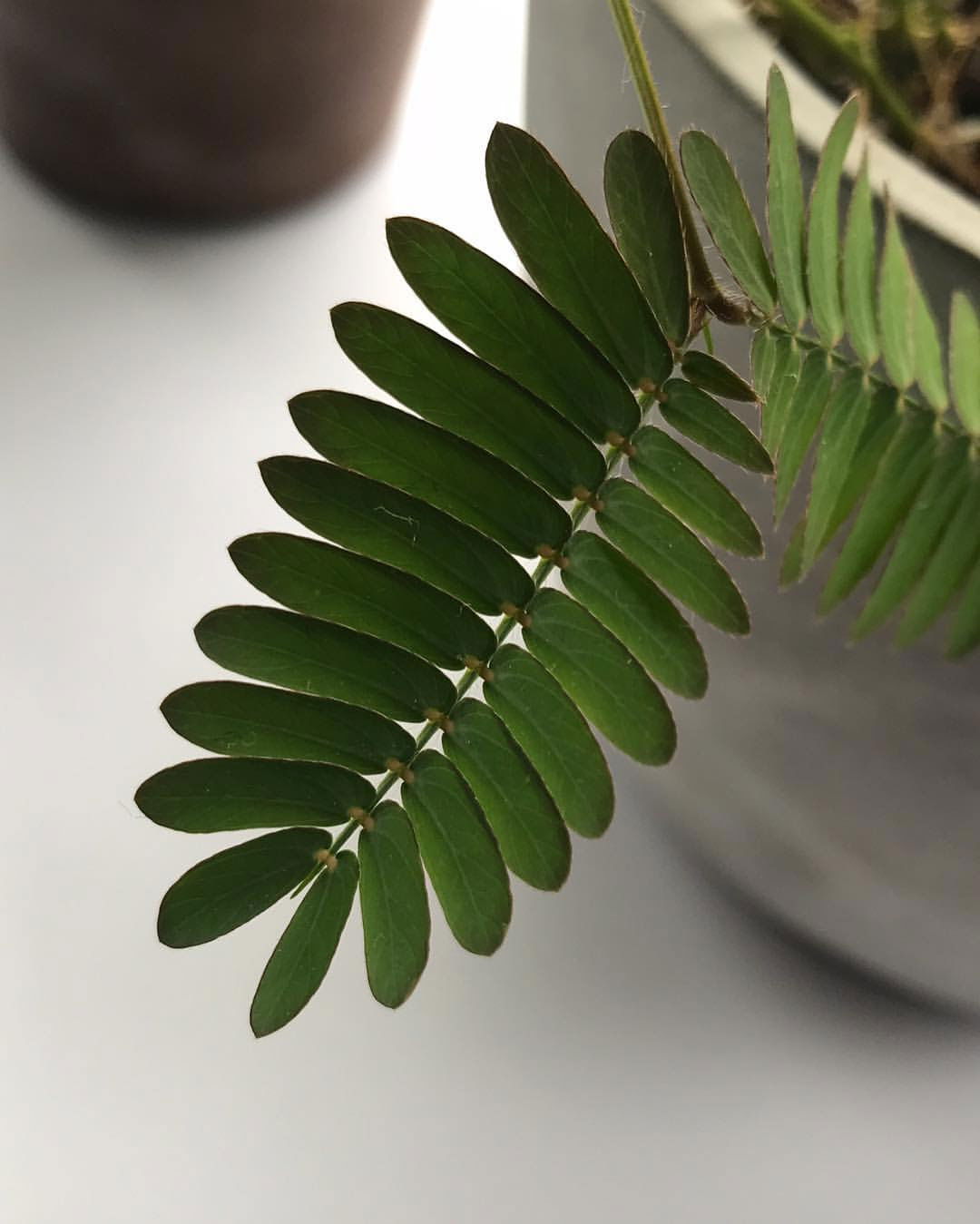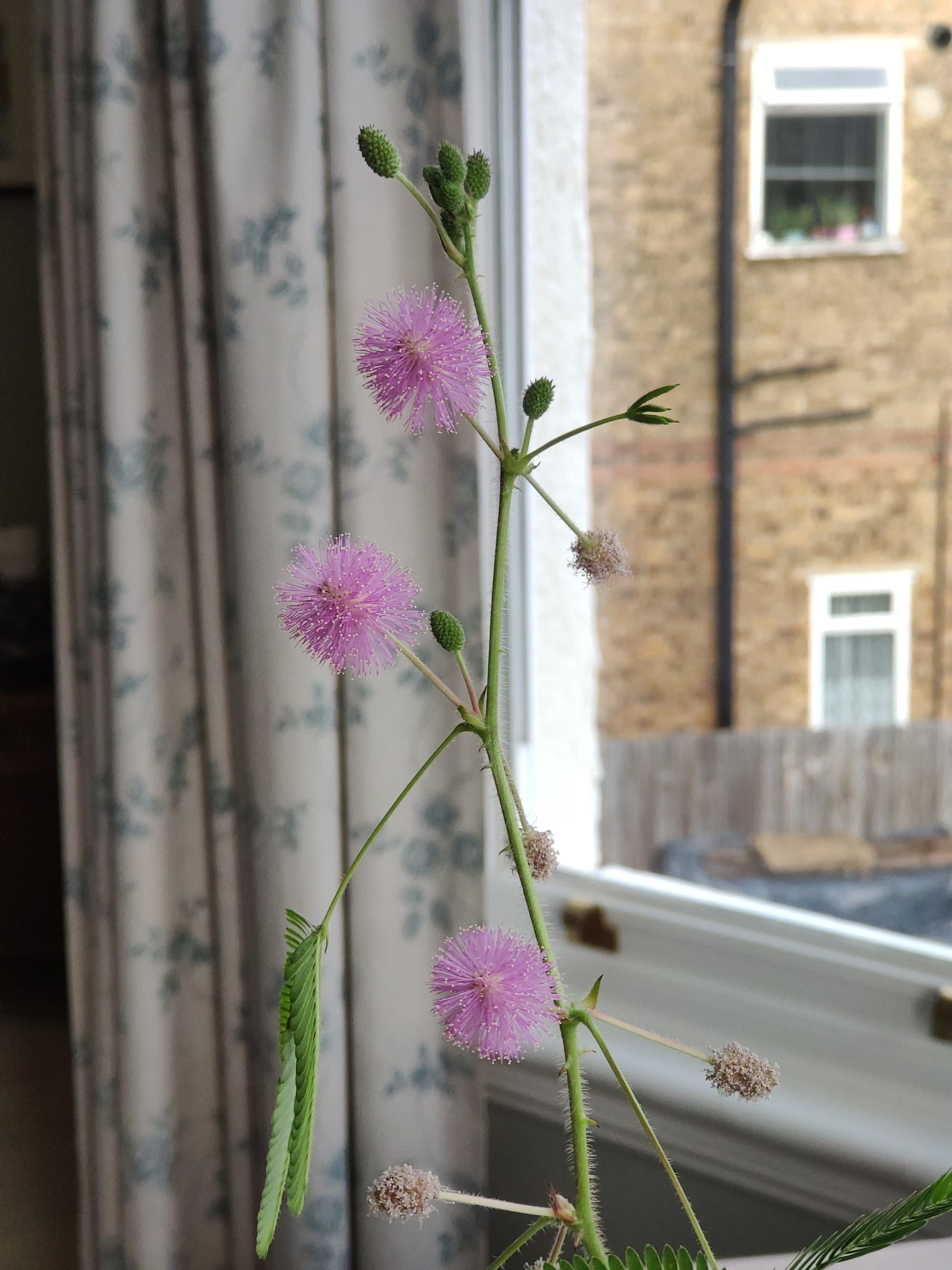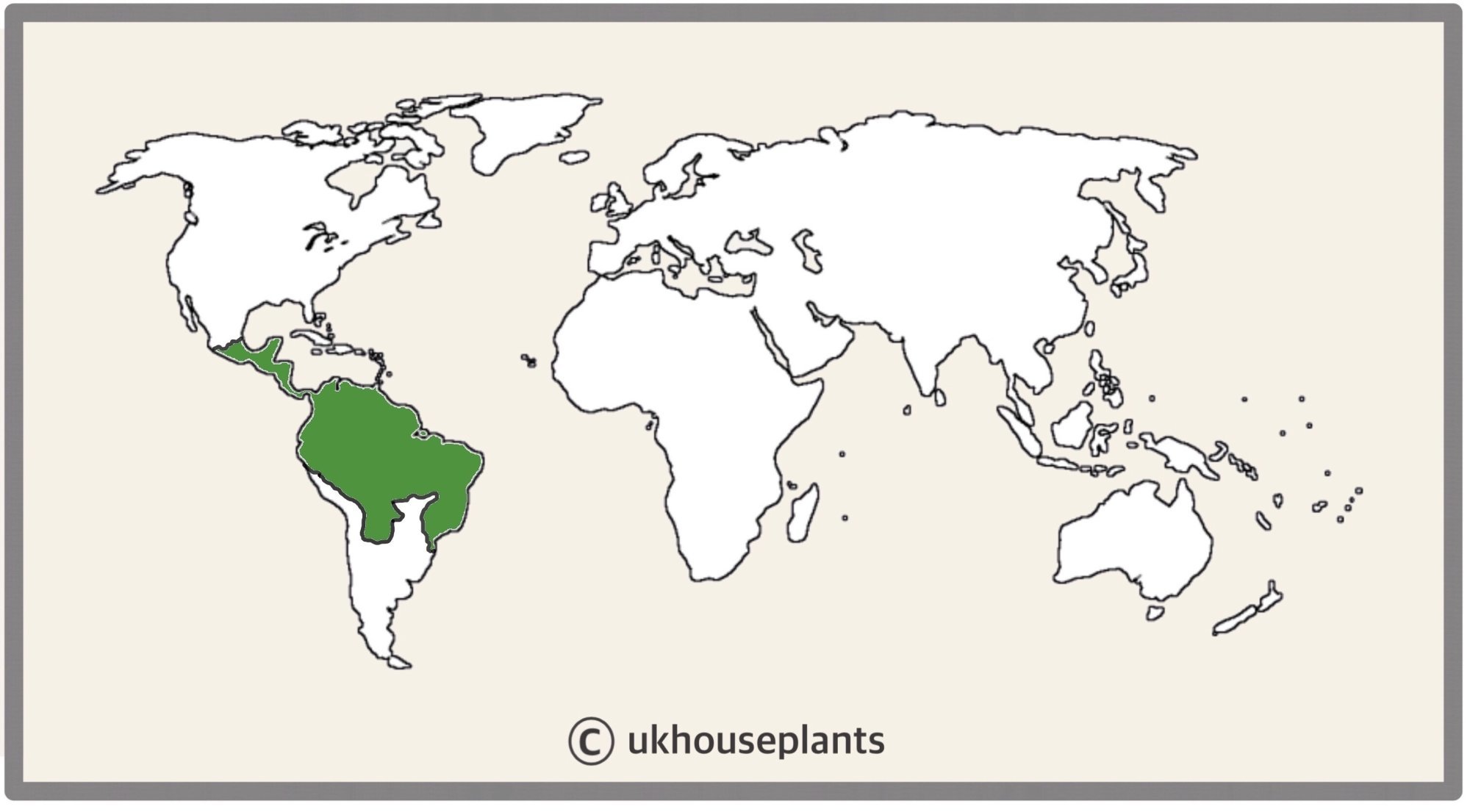
Mimosa pudica
Contents
- Top Tips
- Location, Water, Humidity & Fertilisation
- Common Issues
- Origins, Temperature, Propagation, Repotting & Toxicity
Need the answer to a specific plant query? Book a 1-to-1 video call with THE HOUSEPLANT DOCTOR™, the website's friendly author, to overcome and address your niggling problem! Available on iMessage, WhatsApp, Facebook Messenger & more.
Top Tips & Info
- Care Difficulty - Moderate
- Provide bright, indirect light with an hour of morning or evening sunlight.
- Maintain continual soil moisture due to the species' reduced ability to withstand droughts.
- Introduce a pebble tray to maintain high humidity, as well as to elongate the process of drying soil.
- Supplement at monthly intervals using a 'Houseplant' fertiliser.
- Although repotting isn't wholly necessary, recently-bought specimens may need to be placed in a bigger pot to accommodate the over-populated root systems.
- Mimosa pudica is classed as a biannual, meaning that specimens will rarely make it past two years. Obtaining its seeds via pollination is needed to grow them continually; scroll down to 'Propagation' & 'Flowers' for more information on this.
Location & Light - 🔸🔸🔸
If you search online into the amount of light a Mimosa pudica needs, a wide range of different answers will arise. A brightly lit area with some morning or evening sun is best; however, a location that offers no direct light is also acceptable if you're a forgetful gardener. Avoid excessively dark or bright environments due to the heightened chance of death.
Watering - 🔸🔸🔸
Near-continuous moist soil is mandatory for Mimosa situated in bright locations. Once the top quarter dries out, give the plant a good dose of lukewarm water, avoiding a pool of water to accumulate underneath. Never directly pour cold water into the soil as this will only anger the roots, resulting in flower loss and weak growth. Under-watering symptoms include crispy grey leaves, leaf loss, over-crowding and stunted growth - if there's is a total loss of foliage, scroll down to 'Common Issues' for more information. Over-watering symptoms include the lower leaves rapidly turning yellow and dropping off, a collapsed stem and possible plant death; these issues are usually caused by too little light, standing water and too low heat.
Humidity - 🔸
Although they aren't majorly fussy over the surrounding moisture, introducing a pebble tray will significantly prolong the rates of drying soil, as transpiration loss will be halved, too. For those that are situated in a shady spot, try not to over-mist the foliage or flowers as it'll cause powdery mildew or botrytis to develop across the plant.
Fertilisation - 🔸
Supplement with a 'Houseplant' labelled fertiliser at monthly intervals for the development of better quality foliage. While the specimen is in bloom, switch to a product high in potassium to prolong the duration of flowers - an excellent example of this would be a Poinsettia or Tomato-labelled Feed. Although a general plant fertiliser is acceptable, you'll run the risk of burning the roots if over-applied, especially with the combination of a 'ready-to-use' product and dry soil.
 The beautiful inflorescence of the Mimosa pudica. The two grey flowers below have already been spent, and are now in the process of potential seedpod development. Cross-pollination between two flowers (on separate specimens) may reward you with black poppy-like seeds that you can harvest and sow in the coming springtime. Scroll down to 'Flowers' to learn how you can achieve flowers on your own Mimosa!
The beautiful inflorescence of the Mimosa pudica. The two grey flowers below have already been spent, and are now in the process of potential seedpod development. Cross-pollination between two flowers (on separate specimens) may reward you with black poppy-like seeds that you can harvest and sow in the coming springtime. Scroll down to 'Flowers' to learn how you can achieve flowers on your own Mimosa!
Common Issues with Mimosa Pudica
Under-watering is the biggest threat this species will face, with bright or dry environments antagonising this further. Mimosa will thrive in near-continual moist soil accompanied by an hour of either morning or evening sun. If you're a forgetful gardener, a watering-rota must be introduced to keep on top of hydration, along with a pebble-tray to slow the rates of transpiration (water loss in the leaves).
When a specimen is severely dehydrated, most of its leaves will crisp-up and fall off - leaving you with a naked plant. Although it may spell the end of juvenile plantlets, there may still be light at the end of the tunnel for more established specimens. If its stem is still plump without any signs of retraction, prune-away the seriously affected areas and contain the plant (with its pot) in a transparent bag that has small holes. Keep the soil continually moist, providing a good level of indirect light and temperatures above 15°C (59°F). Remove from the bag after two months of solid foliar growth.
This species is classed as a biannual, which unfortunately means that Mimosa pudica will rarely make it past two years. One way in which you can prolong its life is by pruning back the stem halfway in late summer, to promote a bushier appearance for the following spring. You can even artificially pollinate the spherical flowers that usually bloom around summertime, with the seeds being ready to collect two months later. Moisten a cotton bud and collect pollen off from one plant, and rub it against the seedpod of another. Don't worry if only one of the plants is currently flowering; you can store the pollen on a cotton bud for up to three days in a refrigerator. For more information regarding this method, be sure to scroll down to 'Propagation'.
Too much sunlight will lead to sun scorch, with typical signs including browning or crispy leaves, dry leaf-edges, sunken leaves or stunted growth. Although too little light will cause over-watering issues, excess sunlight will be a detriment to the plant as well. If yours has fallen short of this, reduce the amount of the sun considerably and always be mindful of environmental shock (when two locations offer too different growing conditions). Remove some of the affected leaves and increase waters slightly.
Yellowing lower leaves (closest to soil) are a clear sign of over-watering, usually caused by too little light. Although they can do well in darker locations, the frequency of irrigations must be reduced to counteract the chance of root rot. People don't realise that a plant's root system needs access to oxygen too; when soil is watered, the air will travel upwards and out of the potting mix. A lack of accessible oxygen for the roots will cause them to subsequently breakdown over the oncoming days. Click on this link to learn more about root rot and how to address it, and always feel the pot's weight for confirmation (heaviness = good soil moisture, & vice versa).
Curled leaves and brown leaf-edges are the result of too little water and over-exposure to the sun. Mimosa are best located in bright, indirect settings, and those that haven't acclimatised to the harsh rays will show signs of sun-scorch and environmental shock. A splash of winter sunlight is acceptable as long as the soil moisture is regularly observed, with complete avoidance once summer comes along.
Spider Mites are small, near-transparent critters, that'll slowly suck out the chlorophyll out of the leaves. Have a check under the leaves, most notably along the midrib, for small webs and gritty yellow bumps. Click here to read our article about the eradicating Spider Mites, along with some extra tips that you may not find elsewhere!
Too low humidity can cause browning tips with yellow halos on juvenile leaves. Although this won't kill your specimen, you may want to increase the local moisture to prevent the new growth from adopting these symptoms. Mist or rinse the foliage from time to time and create a humidity tray while the heaters are active to create a stable environment. The browning of leaf-tips on older leaves is wholly natural and is the product of extensive photosynthesis during its life.
Transplant shock is a big issue when it comes to heavy-handed repots. Give the plant a good soak 24hrs before the action and never tinker with the roots, unless it has been affected by root rot. Typical signs of transplant shock are largely similar to under-watering, with wilting, yellowing leaves and stunted growth among the most common symptoms. Click here to learn more about addressing transplant shock, and a step-by-step guide on performing the perfect transplant.
Due to the species’ sensitivity to chemicals, Leaf Shine shouldn't be used to improve the appearance of the foliage, and instead should be cleaned using warm soapy water. Failure to do so may cause yellowed, mottled spots that cannot be undone.
Never allow temperatures to dip below 12ºC (54ºF) as irreversible damage will occur in the likes of yellow foliage and a weakened health. When this happens, remove the severely affected areas and immediately improve growing conditions - never cut through softened yellow growth, and only around brown, crispy squares. As rehabilitation can take several months because of its slow-growing nature, be sure to provide a stable location with better growing conditions to speed this process.
Mould developing on the soil means two things - too little light and over-watering. Despite the harmlessness of the mould, it'll prove unsightly to most gardeners and is therefore removed once known. To remove, replace the top two inches of the soil for a fresh batch of 'Houseplant' compost. Either increase the amount of light received (no direct sunlight for the first few weeks to prevent environmental shock) or decrease the frequency of waters slightly. If the mould is accompanied by yellowing lower leaves, you may also have a case of root rot.
 A two year old Mimosa that was pruned back last autumn.
A two year old Mimosa that was pruned back last autumn.
Origins
Carl Linnaeus first penned the species and genus (Mimosa) in 1753 during a trip to Central America. M. pudica has native origins to Central and South America but has now been artificially introduced to parts of Africa and South-East Asia. They're generally considered a weed that can affect agricultural cultivation of many plants, for example, Bananas, Papaya, Corn and Tomatoes. In 2017, neuroscientist Greg Gage electrically connected a M. pudica to a Venus Fly Trap. He discovered that when its trichomes were triggered, the action caused the other plant's leaves to do so, too.
Many plant parts have a naturally-occurring chemical called 'mimosine', which reportedly has many medicinal properties including the regeneration of nerve stimulation and even antidepressant properties. (Martínez et al., 1996).
 The Distribution of Mimosa pudica.
The Distribution of Mimosa pudica.
Temperature
15° - 29°C (59° - 85°F)
H1a (Hardiness Zone 13) - Must be grown indoors or under glass all year round. Never allow temperatures to dip below 15℃ or permanent damage may occur in the likes of flower loss, stunted growth and yellowed leaves.
Pruning & Maintenance
Remove yellow or dying leaves, and plant debris to encourage better-growing conditions. While pruning, always use clean scissors or shears to reduce the chance of bacterial and fungal diseases. Never cut through yellowed tissue as this may cause further damage in the likes of diseases or bacterial infections. Remember to make clean incisions as too-damaged wounds may shock the plant, causing weakened growth and a decline in health.
Spread
Up to 1m in height and 40cm in width. The ultimate height will take between 1 - 2 years to achieve, with the second season having a limited growth capacity and speed.
Propagation
Via Seed or Stem Cuttings.
Seeds (Easy to Moderate) - Although propagation by seed is exceptionally easy, obtaining the seeds initially can be a struggle. The best way to grow Mimosa pudica annually is by seed, as the plant will acclimatise to your home's environment much better than with those cultivated initially by a nursery. Soak the seeds in lukewarm water for around 24hrs in a dark location, preferably on top of an operating radiator. The best soil to use is a 'Houseplant' labelled potting mix; however, multipurpose compost with added perlite and sand is just as good. Set the seeds around a third-inch into the potting mix, resisting the temptation to compact the soil too much. Maintain evenly moist soil and allow the excess water to freely drain from the pot's base to prevent water-logged conditions. The ideal location for successful germination is in a bright, indirect setting with temperatures above 18℃ (64℉) with bottom-heat. Keep the potted seeds in a transparent bag to provide a stable level of humidity, along with longer-lasting soil moisture. Germination may take up to two months, so don't discard any unsuccessful seeds until this threshold has been surpassed. Remove the bag once the seedlings produce its second leaf and then split them up into their own 3cm pots.
Stem Cuttings (Difficult) - This method of propagation is by far the hardest of the two, and can be taken at the start of Spring when specimens surpass 15cm (6 inches) in height. Either pinch or prune the top 3cm (1.1 inches) of growth with at least to nodes (leaves) - one for foliar growth and the other for root development. Gently remove the lower leaves and set the bottom half of the stem into a moist potting mix. Although we'd recommend using a 'Houseplant' labelled soil, a general-purpose compost with added perlite and sand will work wonders, too. As long as there is a splash of perlite introduced into the mix, oxygen will flow liberally around the cutting's base to reduce the risk of basal rot. Wrap the plant (& its pot) in a transparent bag to maintain high humidity, as an absence of roots will result in moisture loss within the stem. Provide a bright, indirect location with continual soil moisture to quicken the rate of root development, along with better overall health. Remove the bag after four weeks of substantial foliar growth and follow the care advice provided above.
Flowers
Reducing the overall temperature to around 15°C (59°F) with fewer irrigations in the autumn and winter months will significantly increase the chance of flowers in the following spring or summer. In typical Mimosa-fashion, small purple spherical flowers will litter the foliage that can last up several days, as seen above 'Common Issues'. During this period, maintain moist soil with regular feeds of half-strength tomato food to prolong the show. Please note that Mimosa must reach a certain level of maturity to flower, which is at least 40cm (1ft ⅓) in height and usually accompanied by a wooded stem.
Repotting
Not usually necessary due to their one-year life span; however, a newly bought plant may need a repot in 'Houseplant' compost as its roots are quite populous and invasive. Don't worry if the roots smell a bit, this is a natural response by producing fungicides to deter mushrooms from growing near to its rhizosphere.
Pests & Diseases
Keep an eye out for aphids, spider mites, thrips, whitefly, blackfly, vine weevils & root mealybugs that'll locate themselves in the cubbyholes and undersides of the leaves, with the exception of the latter two in the soil. Common diseases associated with Mimosa are root rot, leaf-spot disease, botrytis, rust, powdery mildew & southern blight - click here to learn more about these issues.
Toxicity
This plant is classified as slightly poisonous. If parts of the plants are eaten, vomiting, nausea and a loss of appetite could occur. Consumption of large quantities must be dealt with quickly; acquire medical assistance for further information. As your Mimosa matures, it'll develop sharp thorns at the stem which can puncture skin very quickly, so be wary of this is when handling!
Retail Locations
Blue Diamond & Online Stores.
Book a 1-to-1 Call with THE HOUSEPLANT DOCTOR™
If you need further advice with your houseplants, book an advice call with ukhouseplants' friendly and expert writer today! This can be done via a video or audio call on most apps, including Facebook, FaceTime & Skype. A ten-minute call costs £5.99 (US$7), or £15.99 for thirty minutes. You can ask multiple questions, including queries on plants, pests, terrariums, repotting advice and anything in between. Please consider supporting this service to keep ukhouseplants thriving!